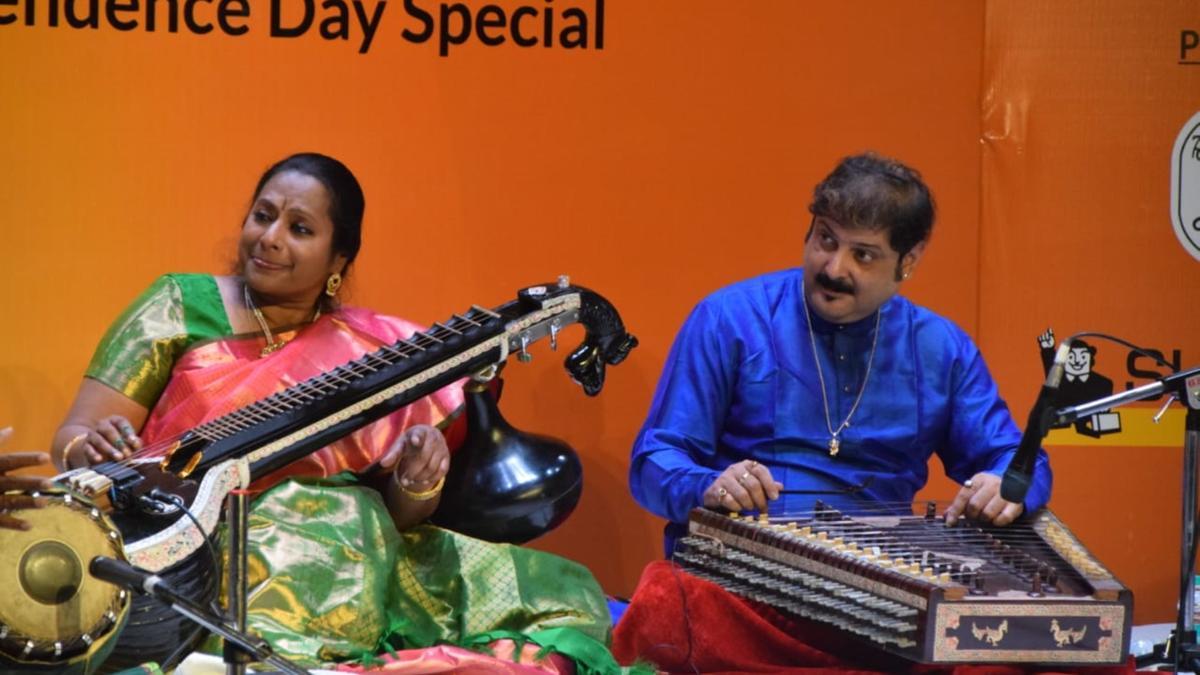
The Saraswati veena, a symbol of India’s ancient classical music tradition, and the santoor, deeply connected to the folk heritage of Kashmir, might seem worlds apart. Yet, uniting these distinctive instruments on stage could create an enchanting symphony of cultural convergence. Recently, in an ambitious endeavor, U.S.-based veena maestro Nirmala Rajasekar and Kolkata’s renowned santoor artiste Sandip Chatterjee brought this novel concept to life. They presented a rare jugalbandi in India just before setting off on their current tour of America.
Together, they orchestrate a melodious blend utilizing 100 strings — 93 belonging to Sandip’s modified santoor (originally 100-stringed) and seven from Nirmala’s veena. This unusual combination highlights an innovative musical dialogue between the two varied classical styles.
Ninth-generation veena virtuoso Nirmala Rajasekar conveyed her excitement about this unique musical collaboration. She shared that this wasn’t the first instance of such a pairing. Historically, veena exponent Kannan Balakrishnan and santoor maestro Bhajan Sopori previously collaborated in a concert organized by Sangeet Natak Akademi, laying groundwork for contemporary musical explorations.
Nirmala and Sandip’s recent performance unfolded in Delhi, where they were joined by Ramdas Palsule on the tabla and Thanjavur K Muruga Bhupathi on the mridangam. The concert was meticulously planned to highlight the distinct qualities of each instrument and their potential to harmonize. Given the shared ragas within the Hindustani and Carnatic music systems, the jugalbandi flowed effortlessly, creating an extraordinary listening experience.
The concert commenced with Nirmala’s rendition of ‘Gam Ganapathe’—an ode to Lord Ganesh—which she complemented with her vocals. Although sometimes her singing slightly diverted attention from the veena, it was masterfully supported by the mridangam’s rhythmic subtleties. In contrast, Sandip offered a distinct ‘gat’ in the raga Hamsadhwani, with Ramdas Palsule’s tabla providing crisp, melodic accompaniment.
The veena’s deep, resonant bass sound starkly contrasts with the light, airy flutter of the santoor.
. While the santoor’s rapid, dexterous note movements are challenging on the veena, the veena’s intricate nuances within each note are unreplicable on the santoor. Despite these differences, both musicians leveraged these unique aspects to enhance and complement each other’s performances.
Sandip revealed that his santoor is typically tuned to ‘D’. However, to align with Nirmala’s veena tuning to ‘E’, he adapted by changing his pitch. Nirmala’s veena, being shorter—for ease of travel—cannot be tuned lower than ‘E’. To adjust, Sandip opted to change his scale and make ‘Re’ his ‘Sa’, a technique not without its challenges. He noted, “I like challenging myself. Instead of re-tuning the santoor to a pitch where it may not resonate well, I adjusted my scale. This approach, although difficult for prolonged performances, enriches the experience.”
Sandip’s approach to santoor playing diverges from tradition. Typically, santoor players use mallets in both hands to produce sound. Sandip, however, uses only one mallet, employing his other hand to pluck the tarab (sympathetic) wires, an innovative technique inspired by Ustad Vilayat Khan saheb’s handling of tarab strings. “Playing with just one mallet and plucking the tarab wires with the other hand produces a beautiful sound,” Sandip explained. He even modified his instrument, reducing the tarab strings to manage resonance.
Their compelling concert demonstrated that despite stylistic divergences and technical challenges, a synthesis of Carnatic and Hindustani traditions is not just possible but profoundly beautiful. The jugalbandi of veena and santoor, enriched by the supportive rhythms of tabla and mridangam, created a mesmerizing musical dialogue, illustrating that in music, convergence is not only achievable but can also produce sublime harmony.
This rare and meticulously structured performance not only delighted the audience but also set a noteworthy precedent for future collaborations between these iconic instruments. As Rajasekar and Chatterjee continue their tour, this unique amalgamation of classical and folk traditions beckons broader audiences, promising an aural experience that celebrates both the diversity and unity of Indian music.
Published – October 01, 2024 03:33 pm IST
Friday Review












